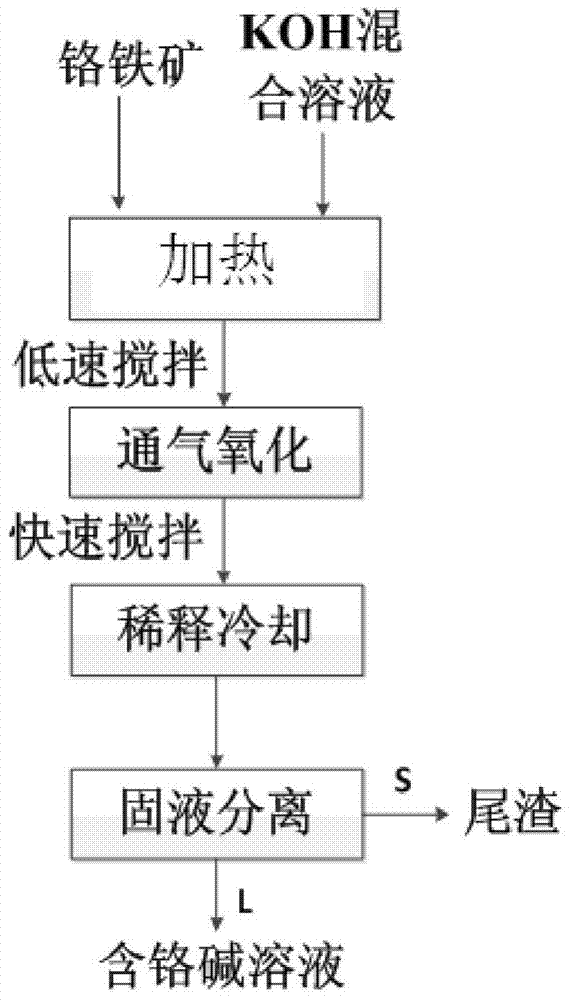Method for extracting chromium from chromite by leaching
A chromite and pressure leaching technology, applied in the direction of improving process efficiency, can solve the problems of difficulty in popularization of industrialization, serious furnace ring formation, and high chromium leaching rate, reducing equipment investment and reducing tailings emissions. , the effect of less environmental pollution
- Summary
- Abstract
- Description
- Claims
- Application Information
AI Technical Summary
Problems solved by technology
Method used
Image
Examples
Embodiment 1
[0041] 13Kg of chromite with particle size below 200 mesh and 45%wt KOH, 10%wt K 2 CO 3 , 8%wt KAlO 2 Add 140L of the mixed solution of chromite into a 200L autoclave, the ratio of alkali to mineral is 8:1, heat to 250°C, then feed oxygen into the solution, and stir evenly, so that the chromite and oxygen are fully mixed, and the total pressure of the control system is 1.5 MPa, react for 6 hours to fully react chromite with oxygen. Finally, a solid-liquid mixed slurry containing iron-rich tailings, potassium chromate, potassium hydroxide, potassium carbonate, potassium metaaluminate and other water-soluble impurity components is obtained, the temperature is lowered, the sample is diluted, and diluted into the reaction slurry for hydrogenation The potassium concentration is 300g / L, and the mixed slurry is filtered and separated at about 80°C to obtain iron-rich tailings and chromium-containing lye respectively. After repeated washing and drying of the tailings, the chromium c...
Embodiment 2
[0042] 22Kg of chromite with particle size below 200 mesh and 50%wt KOH, 10%wt K 2 CO 3 , 10%wt KAlO 2 Add 140L of the mixed solution of chromite into a 200L autoclave, the ratio of alkali to mineral is 5:1, heat to 280°C, then feed oxygen into the solution, and stir evenly, so that the chromite and oxygen are fully mixed, and the total pressure of the control system is 1MPa , to react for 4 hours to fully react the chromite with oxygen. Finally, a solid-liquid mixed slurry containing iron-rich tailings, potassium chromate, potassium hydroxide, potassium carbonate, potassium metaaluminate and other water-soluble impurity components is obtained, the temperature is lowered, the sample is diluted, and diluted into the reaction slurry for hydrogenation The potassium concentration is 300g / L, and the mixed slurry is filtered and separated at about 80°C to obtain iron-rich tailings and chromium-containing lye respectively. After repeated washing and drying of the tailings, the chro...
Embodiment 3
[0043] 36Kg of chromite with a particle size below 200 mesh and 55%wt KOH, 15%wt K 2 CO 3 , 5%wt KAlO 2 Add 140L of the mixed solution of chromite into a 200L autoclave, the ratio of alkali to mineral is 3:1, heat to 260°C, then feed oxygen into the solution, and stir evenly, so that the chromite and oxygen are fully mixed, and the total pressure of the control system is 0.2 MPa, react for 7 hours to fully react chromite with oxygen. Finally, a solid-liquid mixed slurry containing iron-rich tailings, potassium chromate, potassium hydroxide, potassium carbonate, potassium metaaluminate and other water-soluble impurity components is obtained, the temperature is lowered, the sample is diluted, and diluted into the reaction slurry for hydrogenation The potassium concentration is 300g / L, and the mixed slurry is filtered and separated at about 80°C to obtain iron-rich tailings and chromium-containing lye respectively. After repeated washing and drying of the tailings, the chromium...
PUM
| Property | Measurement | Unit |
|---|---|---|
| particle size | aaaaa | aaaaa |
Abstract
Description
Claims
Application Information
 Login to View More
Login to View More - R&D
- Intellectual Property
- Life Sciences
- Materials
- Tech Scout
- Unparalleled Data Quality
- Higher Quality Content
- 60% Fewer Hallucinations
Browse by: Latest US Patents, China's latest patents, Technical Efficacy Thesaurus, Application Domain, Technology Topic, Popular Technical Reports.
© 2025 PatSnap. All rights reserved.Legal|Privacy policy|Modern Slavery Act Transparency Statement|Sitemap|About US| Contact US: help@patsnap.com

